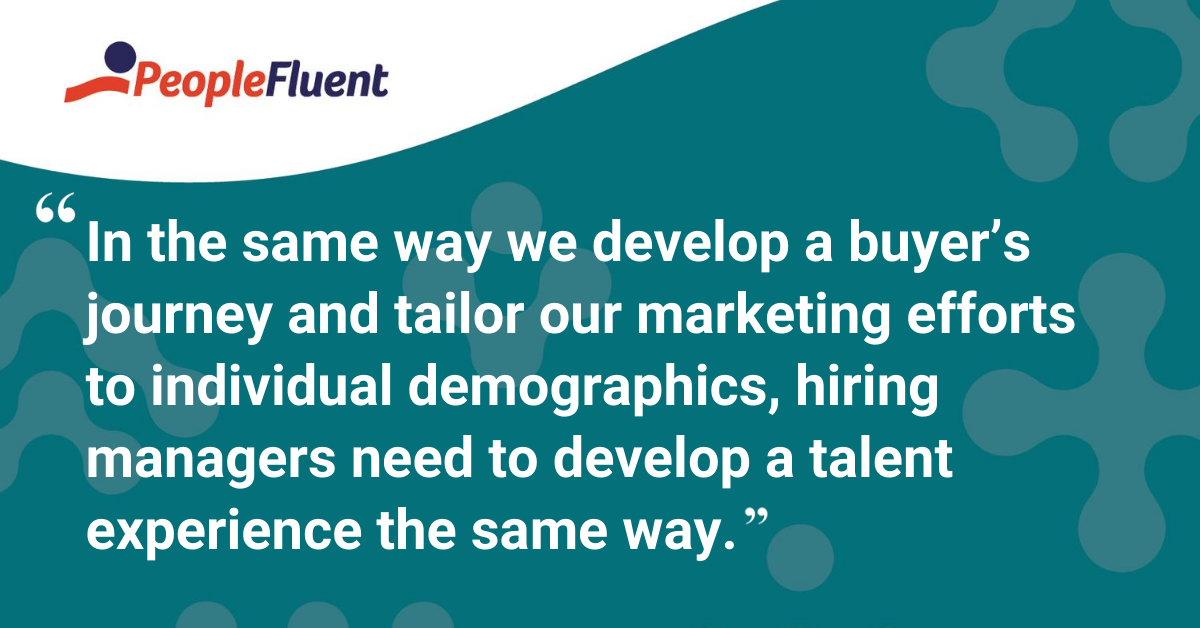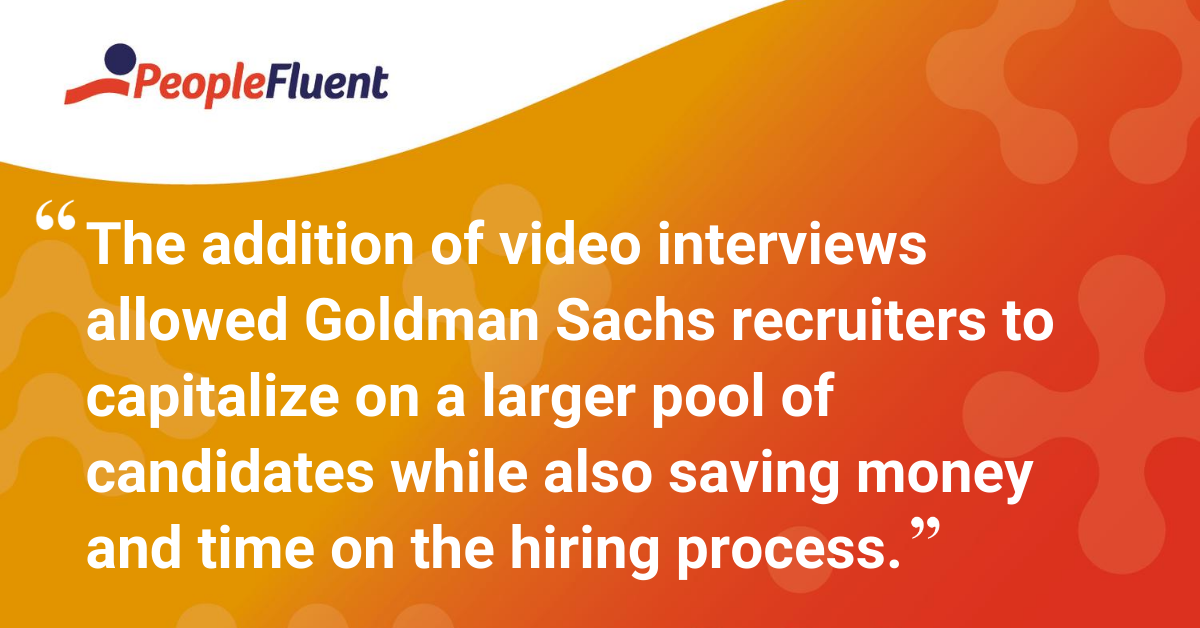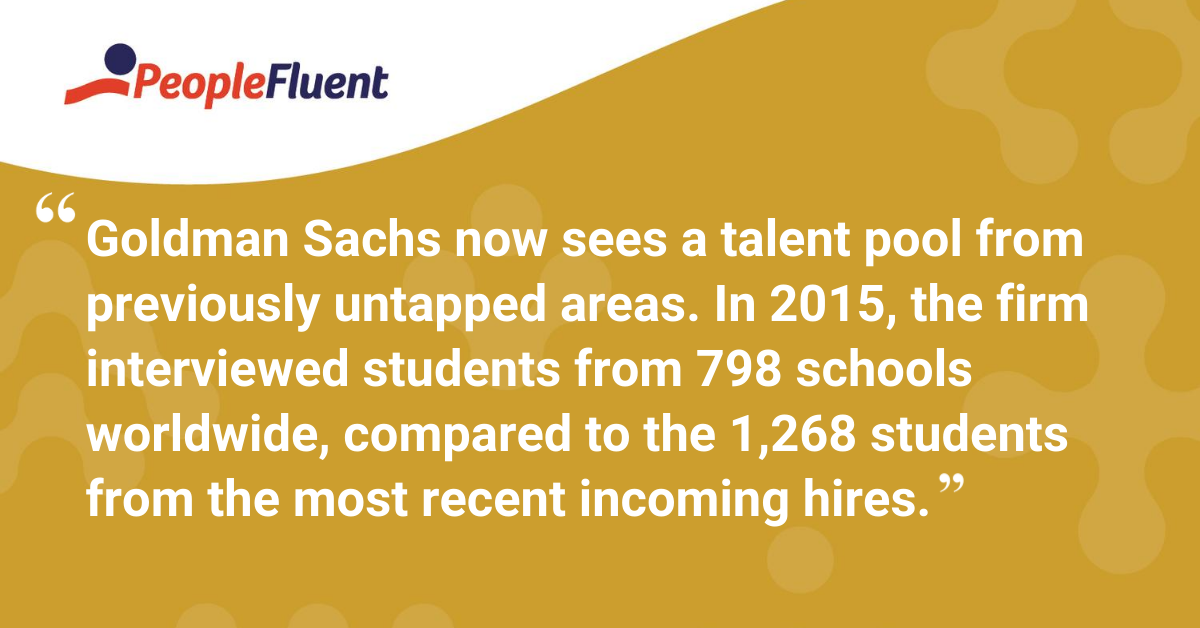Published: Jan 27, 2020Time to read: 8mins Category: Insights
Learn from the Best: How Goldman Sachs Uses Video Interviewing to Improve Talent Experience
Table of Contents
Our ‘Learn from the Best’ articles demonstrate methods and technologies used by successful companies to transform their talent experience. In this article, we’re highlighting how Goldman Sachs personalized the talent experience with the use of video interviewing in their recruitment process.
The talent experience is a candidate’s journey from pre-application to onboarding, consisting of many moving parts throughout the process. Considering its complex nature, savvy employers and HR professionals should find creative ways to personalize the talent experience while ensuring their business goals are being met.
Based on research from Glassdoor, the amount of time employers spend on interviews has almost doubled since 2009. And it makes sense. When it comes to the talent experience, interviews are one of the most difficult techniques to get right.
Employers continue to be heavily focused on using the latest technologies and driving down costs. With the average cost to hire an employee sitting at $4,129, and an average 42 days to fill a position, it’s understandable for employers to be somewhat obsessed. The focus on technological advancements and increasing ROI is necessary to remain competitive. But the ultimate goal—ensuring the best hires possible—seems to have gotten lost in translation.
However, there are a handful of companies that continue to make significant headway in perfecting the hiring experience. In this article, we explore how investment banking company Goldman Sachs appears to have enhanced their talent experience with the use of video interviewing.
You might also like: '5 Candidate Sourcing Strategies to Build Your Talent Pipeline'
Engineering a Better Talent Experience

While companies continue to spend time and money on their hiring processes, one factor that may not be getting enough attention is the talent funnel. Recruiters nowadays take a marketer’s approach in order to keep up with the talent personas they are targeting. Thus, it is important to understand the stages of interaction and appeal to candidates with these principles in mind.
In our highly-digitized world where smartphones are always at our fingertips, the moment of product awareness and purchase (a buyer’s journey) can be simultaneous. That is to say, we may find the exact product we want and make an impulse buy within minutes. Alternatively, we could spend days—even weeks—reading reviews and getting feedback before making a purchase. Similarly, a candidate’s resume could end up in your inbox after they’re refused a raise or during their company’s restructure.
From an employer’s viewpoint, the process is considered a linear pursuit, but the candidate’s journey is not. In the same way we develop a buyer’s journey and tailor our marketing efforts to individual demographics, hiring managers need to develop a talent experience the same way.
By reverse engineering the talent experience and putting the candidate’s journey ahead of your talent funnel, you can create a more meaningful experience that leads to better hires. Whether a great candidate will accept your offer ahead of another company’s is up to your process and how individualized it is to the specific candidate.
Also read: 'Start Before Day One: How Learning Can Inform Talent Acquisition'
How Goldman Sachs Personalizes the Talent Experience

Dane Holmes, former Managing Director at Goldman Sachs, has outlined the company’s struggle with recruiting top talent. After the 2008 financial crisis, the 150-year old firm’s image took a substantial hit which saw its candidate pool decrease. As it watched the talent it was pursuing take positions with private equity firms and Silicon Valley startups, there was a pressing need to respond. Especially as the firm’s demand for candidates with new skillsets—such as coding and data science—grew.
During discussions about overhauling their recruiting process, a task force comprised of senior leaders, data scientists, and other experts questioned why the shift was necessary if there were more qualified applicants than available jobs. “These were reasonable questions,” Holmes writes. “But often staying successful is about learning and changing rather than sticking to the tried-and-true.”
One of the two major additions to Goldman Sachs’ campus recruiting strategy included asynchronous video interviews for first-round interactions—a method in which candidates record their answers to interview questions. This new method replaced their original practice of flying recruiters and business professionals to universities for first-round interviews. The addition of video interviews allowed Goldman Sachs recruiters to capitalize on a larger pool of candidates while also saving money and time on the hiring process.
More from the blog: 'The Role of Video in Future HCM Products [Q&A with Stephen Bruce]'
Asynchronous Video for Recruiting Success
Because the video interviewing process was asynchronous rather than live, the company’s hiring managers could decide on consistent questions to ask while still dedicating the necessary amount of time for candidates to respond. The company has since released a video on what candidates can expect from these video interviews.
Some of the key features of the video-interviewing process include:
- Multi-platform capabilities, allowing candidates to record answers via smartphone, desktop, or tablets
- Candidates from global universities can partake in the process, which expands the talent pool
- Standardized questions developed by recruiters which lead to a consistent and fair interview process for diverse candidates
- Submissions are reviewed by the recruiters and their colleagues, not by AI
- Candidates only have to undergo the video interview process once, even if they apply for multiple positions at Goldman Sachs
- Scheduling is easier as candidates can interview on their own time as long as they return the answers within three days.
In addition to these highlights, hiring managers provided tidbits of advice to help prepare candidates for their video interview. Goldman Sachs has even released a comprehensive list of every question candidates will be asked in an interview with the company, broken up by departments. By being more transparent throughout a candidate’s journey and creating a unique interview process, Goldman Sachs has achieved at least part of their mission: to attract and hire top talent who would have otherwise chosen to work for one of its competitors.
The ROI of a Personalized Talent Experience

The investment bank’s efforts to repair its image and attract new specializations seem to have paid off. With a huge number of applicants (upwards of 250,000) and an acceptance rate of just 4%, the company’s hiring process is as competitive as ever. In 2016, former Goldman Sachs recruiter, Clive Smith, wrote an article demonstrating what the company is truly looking for in a candidate. According to Smith, the new video interviewing process was designed to mirror traits the firm is looking for in a candidate: unique, diverse, and interesting.
Holmes believes the overhaul to include video interviewing was successful in two ways. First, recruiters and hiring managers can spend more time getting to know their applicants. In 2015, just a year prior to rolling out the video interviewing platform, Goldman Sachs interviewed fewer than 20% of their campus applicants. The hard work began to pay off in 2018— two years after the platform went live—when 40% of the student applicants participated in a first-round video interview.
Second, Goldman Sachs now sees a talent pool from previously untapped areas. In 2015, the firm interviewed students from 798 schools worldwide, compared to the 1,268 students from the most recent incoming hires. “In the United States, where the majority of our student hires historically came from ‘target schools,’ the opposite is now true,” Holmes wrote. “The top of our recruiting funnel is wider, and the output is more diverse.”
In all, the investment banking firm is confident in its new recruiting process and continues to redesign it to keep up with the digital era. For instance, Holmes wrote about the firm’s most ambitious recruiting campaign, “Day in the Life,” which launched in September 2019. The campaign focuses on several young professionals of diverse backgrounds who work at the firm. These employees took part in a series of well-produced vlogs to introduce themselves and explain what they enjoy about working for Goldman Sachs.
The angle? To continue attracting talented young professionals by humanizing the process and making the candidate’s journey more individualized. After all, wouldn’t you want to buy something if the influencer endorsing it looked or behaved like you? The use of social proof is one of the most persuasive marketing—and now recruiting—tools available. Wondering why? It's genuine. And it’s personal.
Keep reading: 'Choosing Your Next Enterprise ATS: 4 Must-Have Features'
Discover How Recruitment Lets You Find the Right People—Fast
PeopleFluent helps you fill critical roles with the right people and the right skillsets on a global scale. At the same time, it helps you build your employer brand and sharpen your competitive edge.